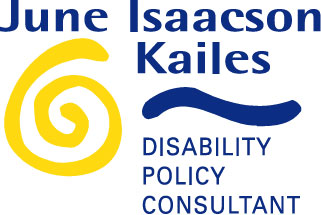

Emergency Registries
NEW
Comments: City of
Los Angeles Commission on
Disability 6/12/25 Public Hearing mergency
evacuation policies,
procedures, and services for people with disabilities in
Greater Los Angeles.

The focus and context
are life-threatening disasters* that overwhelm local resources versus
local
emergencies, which usually and effectively use available response
resources to
deal with house fires, downed power lines, and vehicle accidents.
The resources below aim to
clarify the layers cut through the
rhetoric, and examine the dis, mis, and flawed information regarding
registries. The term registries, used here and sometimes referred
to as
“special needs” registries or registries for disabled people,” are a
disaster
response and planning tool.
These resources expand on
June Kailes’ efforts, along with
colleagues, to broaden the thoughtful, thorough, and honest analysis of
the
actual value of emergency registries.
There are huge
differences between:
Planning Information:
Registries do not provide accurate data
about the demographic and geographic distribution patterns in
jurisdiction.
underestimates of data, contribute to false
confidence in wrong decisions.
Registries are not the way to define
needs. There are better tools and
resources that exist or can be refined/developed with the appropriate
involvement of subject matter experts with experience with disability
and
disaster.

An emergency
is an urgent, sudden, and serious event or an
unexpected change in conditions that needs immediate action to resolve
harm or
prevent imminent danger to life, health, or property.
An emergency is
usually a small-scale, local incident that is
handled quickly using local resources.
* Disasters are severe disruptions to the functioning of a community that exceeds its capacity to cope using its resources.A disaster is a large-scale, widespread event that may cross geographic and political boundaries. A disaster requires coordinated action across multiple entities and levels of government to resolve; it may be natural (floods, wildfires, or human-cause (war, terrorist attacks); or technological (power outages, cyber-attacks). Common to all definitions of disaster: the disruption overwhelms the ability of the affected communities to cope using their resources.
**Symbolic
planning
refers
to guesses based
on untried, undocumented, or unsuccessful practices. Symbolic
plans lack specifics of who,
what, where, when and how.


Emergency Registries - an expanded discussion of emergency registry content and recommendations covered in Getting it Wrong: An Indictment with a Blueprint for Getting It Right (2018). Covers the challenges and shortcomings of existing emergency registries with examples from recent hurricanes in Texas and Florida, as well as other disasters. Recommendations focus on the need to look beyond emergency registries to the new, ubiquitous technologies that more easily connect people with disabilities and others with access and functional needs to the supports and assistance they need in their communities before, during, and after a significant emergency.

The focus and context are
life-threatening disasters* that
overwhelm local resources versus local emergencies, which usually and
effectively use available response resources to deal with house fires,
downed
power lines, and vehicle accidents.
The resources below aim to clarify
the layers cut through the rhetoric, and examine the dis, mis, and
flawed
information regarding registries. The term registries, used here and sometimes referred to as “special needs”
registries
or registries for disabled people,” are a disaster response and
planning tool.
These
resources expand on June Kailes’ efforts, along with
colleagues, to broaden the thoughtful, thorough, and honest analysis of
the actual
value of emergency registries.
There
are huge
differences between:

Emergency
Registries for People with Access
and Functional Needs
By June
Isaacson Kailes and Alexandra Enders
© 2014
Emergency
registries may
seem like an easy and logical answer for addressing what are perceived
as
“special needs” for a small segment of the population. In
reality,
registry issues are complex, and the needs when functionally
defined, are
not special, and are not limited to just a small group of people with
disabilities and others with access and functional needs (Kailes
and Enders, 2007).
We
continue to discuss emergency registry
issues, and aren't quite ready to write a peer reviewed journal
article. But we
have developed so much material over the last decade that we decided it
was
time to make some of it available online.
We
are including a flowchart
and assessment tool
for making decisions about using a registry; a
compilation of opinions
about registries; background discussion on what
registries are,
and the types of registries used in emergency management; links to some of the existing registries, so
you can
see the variation that exists.
We
are still compiling additional
registry materials such as: a registry evaluation tool useful to
consumers
and community organizations; alternatives to using registries;
technology
approaches in public and private sectors; whole community planning
strategies
which fully integrate people with access and functional needs, and
registry
research needed.
These
pages represents our work in progress,
discussions, drafts of articles and content presented at workshops
and webinars.
We encourage you to help refine its content,
identify additional resources, and provide feedback about what works,
doesn’t
work, or needs work. Please include “Registry feedback” in the
subject
line of your message to jik@pacbell.net.

Emergency Registries:
Research
Due
to scarce and piecemeal research on registries, there is a lack of data
for
organizations contemplating creating and maintaining registries.
Much of
the available guidance is hypothetical and untested, especially in
large scale
emergencies. There is little to no documented evidence that when
activated
emergency registries for people with disabilities and others with
access and
functional needs have made a difference in protecting people’s life,
health,
and safety.
This is
a work in progress designed to evolve based on new learning and
continuous
feedback as new methods and tools become available. You are
encouraged to
refine its content, by providing additional resources, as well as
feedback
about what works, doesn’t work, or needs work. Please include
“Registry
feedback” in the subject line of your message to jik@pacbell.net

 jik@pacbell.net
jik@pacbell.net
© 2022 June Isaacson
Kailes, Disability Policy Consultant, All Rights Reserved.
Created1/1/14
| Updated 06.09.25